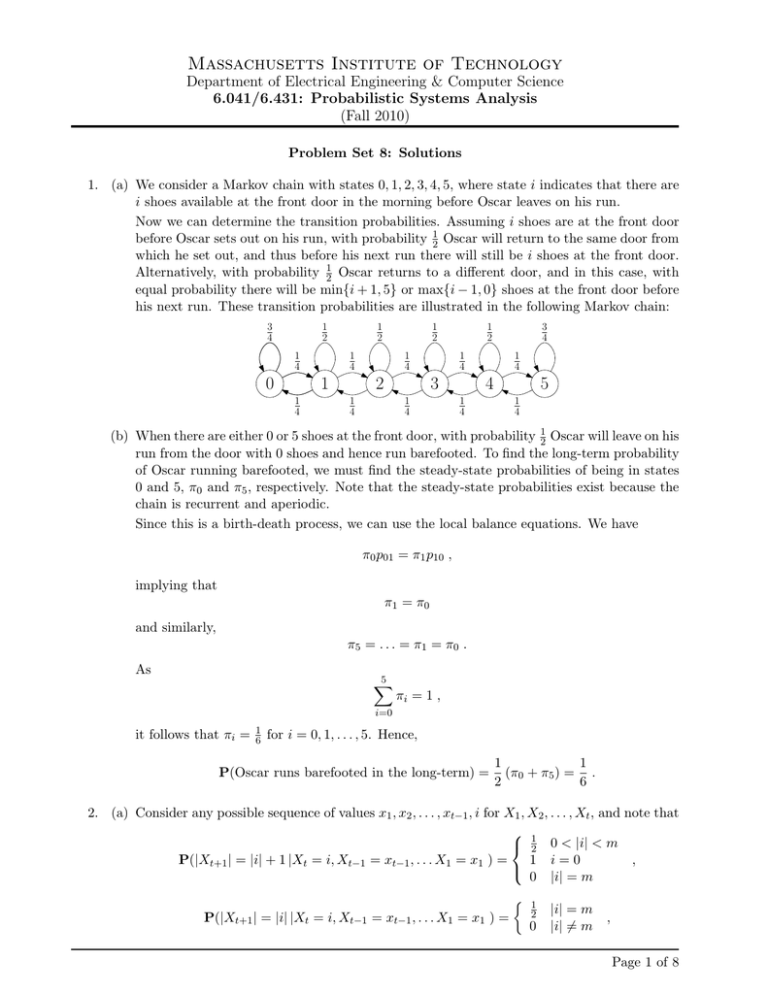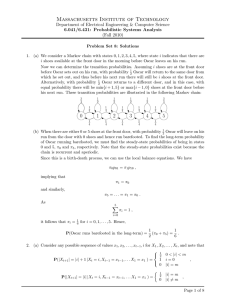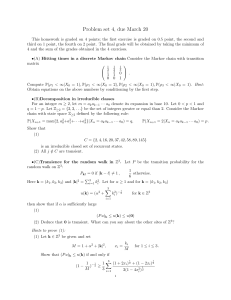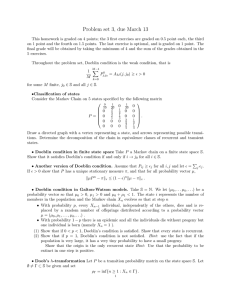Massachusetts Institute of Technology
advertisement

Massachusetts Institute of Technology
Department of Electrical Engineering & Computer Science
6.041/6.431: Probabilistic Systems Analysis
(Fall 2010)
Problem Set 8: Solutions
1. (a) We consider a Markov chain with states 0, 1, 2, 3, 4, 5, where state i indicates that there are
i shoes available at the front door in the morning before Oscar leaves on his run.
Now we can determine the transition probabilities. Assuming i shoes are at the front door
before Oscar sets out on his run, with probability 12 Oscar will return to the same door from
which he set out, and thus before his next run there will still be i shoes at the front door.
Alternatively, with probability 12 Oscar returns to a different door, and in this case, with
equal probability there will be min{i + 1, 5} or max{i − 1, 0} shoes at the front door before
his next run. These transition probabilities are illustrated in the following Markov chain:
3
4
1
2
1
4
1
2
1
4
1
0
1
4
1
2
1
4
2
1
2
1
4
3
1
4
3
4
1
4
1
4
4
5
1
4
1
4
(b) When there are either 0 or 5 shoes at the front door, with probability 12 Oscar will leave on his
run from the door with 0 shoes and hence run barefooted. To find the long-term probability
of Oscar running barefooted, we must find the steady-state probabilities of being in states
0 and 5, π0 and π5 , respectively. Note that the steady-state probabilities exist because the
chain is recurrent and aperiodic.
Since this is a birth-death process, we can use the local balance equations. We have
π0 p01 = π1 p10 ,
implying that
π1 = π0
and similarly,
π5 = . . . = π1 = π0 .
As
5
X
πi = 1 ,
i=0
it follows that πi =
1
6
for i = 0, 1, . . . , 5. Hence,
P(Oscar runs barefooted in the long-term) =
1
1
(π0 + π5 ) = .
2
6
2. (a) Consider any possible sequence of values x1 , x2 , . . . , xt−1 , i for X1 , X2 , . . . , Xt , and note that
1
2 0 < |i| < m
1 i=0
P(|Xt+1 | = |i| + 1 |Xt = i, Xt−1 = xt−1 , . . . X1 = x1 ) =
,
0 |i| = m
P(|Xt+1 | = |i| |Xt = i, Xt−1 = xt−1 , . . . X1 = x1 ) =
1
2
0
|i| = m
|i| 6= m
,
Page 1 of 8
Massachusetts Institute of Technology
Department of Electrical Engineering & Computer Science
6.041/6.431: Probabilistic Systems Analysis
(Fall 2010)
P(|Xt+1 | = |i| − 1 |Xt = i, Xt−1 = xt−1 , . . . X1 = x1 ) =
1
2
0
P(|Xt+1 | = j |Xt = i, Xt−1 = xt−1 , . . . X1 = x1 ) = 0 ,
0 < |i| ≤ m
i=0
,
||i| − j| > 1 .
As the conditional probabilities above only depend on |i|, where |Xt | = |i|, it follows that
|X1 |, |X2 |, . . . satisfy the Markov property. The associated Markov chain is illustrated below.
1/2
1
0
1/2
1/2
1/2
1/2
1
1/2
m
m -1
1/2
1/2
(b) Note that Y1 , Y2 , . . . is not a Markov chain for m > 1, because
P(Yt+1 = d + 1|Yt = d, Yt−1 = d − 1) =
1
2
does not equal
P(Yt+1 = d + 1|Yt = d, Yt−1 = d, Yt−2 = d − 1) = 0 ,
for 0 < d < m (the idea is that if Yt−2 = d − 1, Yt−1 = d, and Yt = d, then |Xt | = d − 1,
while if Yt−1 = d − 1, and Yt = d, then |Xt | = d). If, however, we keep track of |Xt |
and Yt , we do have a Markov chain, because for any possible sequence of pairs of values
(x1 , y1 ), . . . , (xt−1 , yt−1 ), (i1 , i2 ) for (|X1 |, Y1 ), . . . , (|Xt−1 |, Yt−1 ), (|Xt |, Yt ),
P((|Xt+1 |, Yt+1 ) = (i1 + 1, i2 + 1)
P((|Xt+1 |, Yt+1 ) = (i1 − 1, i2 )
P((|Xt+1 |, Yt+1 ) = (i1 , i2 )
|
(|Xt |, Yt ) = (i1 , i2 ), . . . (|X1 |, Y1 ) = (x1 , y1 ))
1
2 0 < i1 = i2 < m
1 i1 = i2 = 0
=
,
0 otherwise
|
(|Xt |, Yt ) = (i1 , i2 ), . . . (|X1 |, Y1 ) = (x1 , y1 ))
1
2 0 < i1 ≤ i2 ≤ m ,
=
0 otherwise
|
(|Xt |, Yt ) = (i1 , i2 ), . . . (|X1 |, Y1 ) = (x1 , y1 ))
1
2 i1 = i2 = m ,
=
0 otherwise
from which it is clear that the conditional probabilities only depend on (i1 , i2 ), the values
of |Xt | and Yt , respectively. The corresponding Markov chain is illustrated below.
Page 2 of 8
Massachusetts Institute of Technology
Department of Electrical Engineering & Computer Science
6.041/6.431: Probabilistic Systems Analysis
(Fall 2010)
1/2
1/2
1/2
1
(0, m)
(1, m)
1/2
1
(0, m-1)
(m, m)
(m-1,m)
1/2
1/2
1/2
1/2
(1, m-1)
1/2
1/2
1/2
1/2
(m-1, m-1)
1/2
1/2
1/2
1
1/2
(0, 1)
(1, 1)
1/2
1
(0, 0)
3. (a) If m out of n individuals are infected, then there must be n − m susceptible individuals.
Each one of these individuals will be independently infected over the course of the day with
probability ρ = 1 − (1 − p)m . Thus the number of new infections, I, will be a binomial
random variable with parameters n − m and ρ. That is,
n−m k
pI (k) =
k = 0, 1, . . . , n − m .
ρ (1 − ρ)n−m−k
k
(b) Let the state of the SIS model be the number of infected individuals. For n = 2, the
corresponding Markov chain is illustrated below.
1
pq+(1- p)(1- q)
(1- q)2
p(1-q)
0
2
1
q(1- p)
2q(1- q)
q2
(c) The only recurrent state is the state with 0 infected individuals.
(d) Let the state of the SIR model be (S, I), where S is the number of susceptible individuals
and I is the number of infected individuals. For n = 2, the corresponding Markov chain is
illustrated below.
Page 3 of 8
Massachusetts Institute of Technology
Department of Electrical Engineering & Computer Science
6.041/6.431: Probabilistic Systems Analysis
(Fall 2010)
1
1
1
(0,0)
(1, 0)
(2, 0)
q
q2
pq
(1- p)q
(0,1)
(1, 1)
2q(1- q)
(1- q)
(0,2)
(1- p)(1- q)
p(1- q)
(1- q)2
If one did not wish to keep track of the breakdown of susceptible and recovered individuals
when no one was infected, the three states free of infections could be consolidated into a
single state as illustrated below.
1
(∗,0)
q
q2
pq
(0,1)
(1- p)q
(1, 1)
2q(1- q)
(1- q)
(0,2)
(1- p)(1- q)
p(1- q)
(1- q)2
(e) Any state where the number of infected individuals equals 0 is a recurrent state. For n = 2,
there are either one or three recurrent states, depending on the Markov chain drawn in part
(d).
4. (a) The process is in state 3 immediately before the first transition. After leaving state 3 for
the first time, the process cannot go back to state 3 again. Hence J, which represents the
number of transitions up to and including the transition on which the process leaves state 3
for the last time is a geometric random variable with success probability equal to 0.6. The
variance for J is given by:
1−p
10
σJ2 =
=
2
p
9
Page 4 of 8
Massachusetts Institute of Technology
Department of Electrical Engineering & Computer Science
6.041/6.431: Probabilistic Systems Analysis
(Fall 2010)
(b) There is a positive probability that we never enter state 4; i.e., P (K < ∞) < 1. Hence the
expected value of K is ∞.
(c) The Markov chain has 3 different recurrent classes. The first recurrent class consists of
states {1, 2}, the second recurrent class consists of state {7} and the third recurrent class
consists of states {4, 5, 6}. The probability of getting absorbed into the first recurrent class
starting from the transient state 3 is,
1/10
1
=
1/10 + 2/10 + 3/10
6
which is the probability of transition to the first recurrent class given there is a change of
state. Similarly, probability of absorption into second and third recurrent classes are 36 and
2
6 respectively.
Now, we solve the balance equations within each recurrent class, which give us the probabili­
ties conditioned on getting absorbed from state 3 to that recurrent class. The unconditional
steady-state probabilities are found by weighing the conditional steady-state probabilities
by the probability of absorption to the recurrent classes.
The first recurrent class is a birth-death process. We write the following equations and solve
for the conditional probabilities, denoted by p1 and p2 .
p1 =
p2
2
p1 + p2 = 1
Solving these equations, we get p1 = p2 = 23 . For the second recurrent class, p7 = 1. The
third recurrent class is also a birth-death process, we can find the conditional steady-state
probabilities as follows,
p4 = 2p5
1
3,
p5 = 2p6
p 4 + p5 + p6 = 1
and thus, p4 = 47 , p5 = 27 , p6 = 17 .
Using these data, the unconditional steady-state probabilities for all the states are found as
follows:
1 1
1
π1 = · =
3 6
18
2 1
1
π2 = · =
3 6
9
π3 = 0 (transient state)
3
1
π7 = 1 · =
6
2
4 2
4
π4 = · =
7 6
21
2 2
2
π5 = · =
7 6
21
1 2
1
π6 = · =
7 6
21
Page 5 of 8
Massachusetts Institute of Technology
Department of Electrical Engineering & Computer Science
6.041/6.431: Probabilistic Systems Analysis
(Fall 2010)
(d) The given conditional event, that the process never enters state 4, changes the absorption
probabilities to the recurrent classes. The probability of getting absorbed to the first re­
current class is 14 , to the second recurrent class is 34 , and to the third recurrent class is 0.
Hence, the steady state probabilities are given by,
π1 =
1 1
1
· =
3 4
12
2 1
1
· =
3 4
6
π3 = π4 = π5 = π6 = 0
3
3
π7 = 1 · =
4
4
For pedagogical purposes, let us actually draw what the new Markov chain would look like,
given the event that the process never enters state 4. The resulting chain is shown below.
Let us see how we came up with these transition probabilities.
π2 =
4/10
1/2
1
S1
S2
1/2
S3
3/20
9/20
S7
1
We need to be careful when rescaling the new transition probabilities. First of all, it is clear
that the probabilities within the recurrent classes {S1, S2} and {S7} don’t get affected.
We also note that the self loop transition probability of the transient state S3 doesn’t get
changed either.(this would be true for any other transient state)
To see that the self loop probability p3,3 doesn’t get changed, we condition on the event
that we eventually enter S2 or S7. Let’s call the new self loop probability, q3,3 .
Then,
q3,3 = P (X1 = S3| absorbed into 2 or 7, X0 = S3) =
=
p3,3 ∗(a3,2 +a3,7 )
(a3,2 +a3,7 )
= p3,3 =
p3,3 ∗P (absorbed into 2 or 7 |X1 =S3, X0 =S3)
P (absorbed into 2 or 7 | X0 =S3)
4
10
Now, we calculate q3,7 and q3,2 .
q3,7 = P (X1 = S7| absorbed into 2 or 7, X0 = S3) =
=
p3,7 ∗1
(a3,2 +a3,7 )
=
3
10
1
1
+
6
2
=
p3,7 ∗P (absorbed into 2 or 7 |X1 =S7, X0 =S3)
P (absorbed into 2 or 7 | X0 =S3)
9
20
Page 6 of 8
Massachusetts Institute of Technology
Department of Electrical Engineering & Computer Science
6.041/6.431: Probabilistic Systems Analysis
(Fall 2010)
q3,2 = P (X1 = S2| absorbed into 2 or 7, X0 = S3) =
=
p3,2 ∗1
(a3,2 +a3,7 )
=
1
10
1
1
+
2
6
=
p3,2 ∗P (absorbed into 2 or 7 |X1 =S2, X0 =S3)
P (absorbed into 2 or 7 | X0 =S3)
3
20
Now, we can calculate the absorption probabilities of this new Markov chain.
The probability of getting absorbed into the recurrent class {1, 2}, starting from S3, is
3
20
3
9
+
20
20
S3, is
= 1
4 . The probability of getting absorbed into the recurrent class {7}, starting from
9
20
9
3
+ 20
20
= 43
. Thus, our calculated absorption probabilities match the probabilities we
intuited earlier. The important thing to take away from this example is that, when doing
problems of this sort, (i.e given we do/don’t enter a particular set of recurrent classes), it
is neccessary to rescale the transition probabilities of the new chain, coming out of ALL
the transient states. In other words, to find each of the new transition probabilities, we
condition on the given event, that we do or do not enter particular recurrent classes.
G1† . a) First let the pij ’s be the transition probabilities of the Markov chain.
Then
mk+1 (1) = E[Rk+1 |X0 = 1]
= E[g(X0 ) + g(X1 ) + ... + g(Xk+1 )|X0 = 1]
n
X
=
p1i E[g(X0 ) + g(X1 ) + ... + g(Xk+1 )|X0 = 1, X1 = i]
i=1
=
n
X
p1i E[g(1) + g(X1 ) + ... + g(Xk+1 )|X1 = i]
i=1
= g(1) +
= g(1) +
n
X
i=1
n
X
p1i E[g(X1 ) + ... + g(Xk+1 )|X1 = i]
p1i mk (i)
i=1
and thus in general mk+1 (c) = g(c) +
Pn
i=1 pci mk (i)
when c ∈ {1, ..., n}.
Note that the third equality simply uses the total expectation theorem.
b)
vk+1 (1) = V ar[Rk+1 |X0 = 1]
= V ar[g(X0 ) + g(X1 ) + ... + g(Xk+1 )|X0 = 1]
= V ar[E[g(X0 ) + g(X1 ) + ... + g(Xk+1 )|X0 = 1, X1 ]] +
Page 7 of 8
Massachusetts Institute of Technology
Department of Electrical Engineering & Computer Science
6.041/6.431: Probabilistic Systems Analysis
(Fall 2010)
E[V ar[g(X0 ) + g(X1 ) + ... + g(Xk+1 )|X0 = 1, X1 ]]
= V ar[g(1) + E[g(X1 ) + ... + g(Xk+1 )|X0 = 1, X1 ]] +
E[V ar[g(1) + g(X1 ) + ... + g(Xk+1 )|X0 = 1, X1 ]]
= V ar[E[g(X1 ) + ... + g(Xk+1 )|X0 = 1, X1 ]] + E[V ar[g(X1 ) + ... + g(Xk+1 )|X0 = 1, X1 ]]
= V ar[E[g(X1 ) + ... + g(Xk+1 )|X1 ]] + E[V ar[g(X1 ) + ... + g(Xk+1 )|X1 ]]
= V ar[mk (X1 )] + E[vk (X1 )]
2
2
= E[(mk (X1 )) ] − E[mk (X1 )] +
=
n
X
p1i m2k (i)
i=1
so in general vk+1 (c) =
† Required
n
X
n
X
−(
p1i mk (i))2 +
i=1
Pn
2
i=1 pci mk (i)
for 6.431; optional for 6.041
p1i vk (i)
i=1
n
X
p1i vk (i)
i=1
P
P
− ( ni=1 pci mk (i))2 + ni=1 pci vk (i) when c ∈ {1, ..., n}.
Page 8 of 8
MIT OpenCourseWare
http://ocw.mit.edu
6.041 / 6.431 Probabilistic Systems Analysis and Applied Probability
Fall 2010
For information about citing these materials or our Terms of Use, visit: http://ocw.mit.edu/terms.







